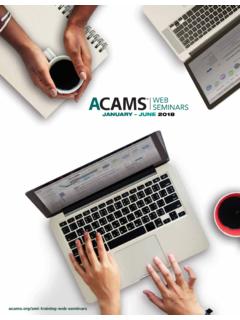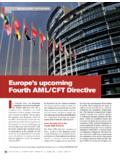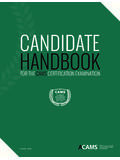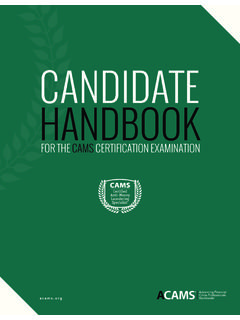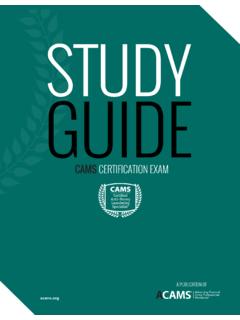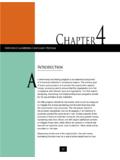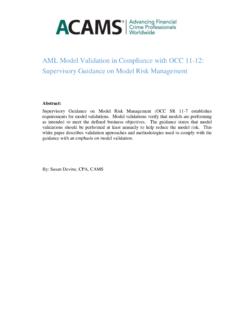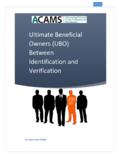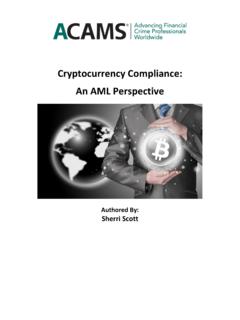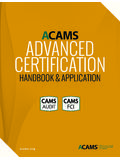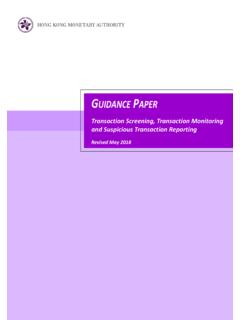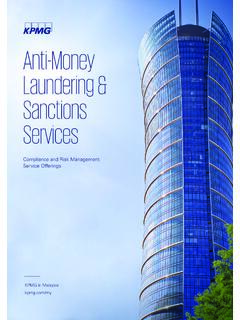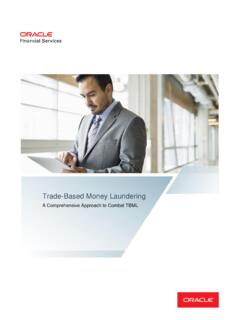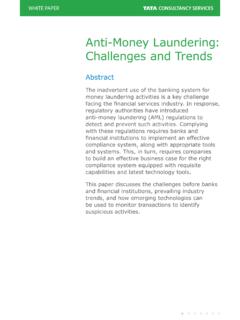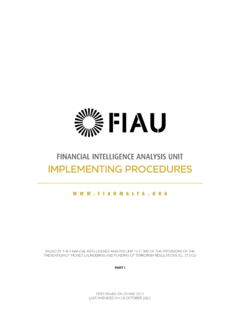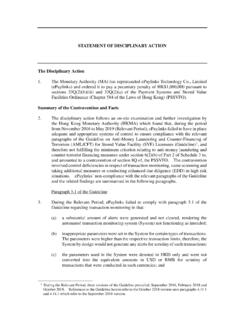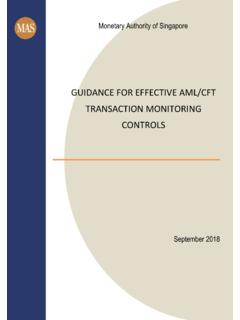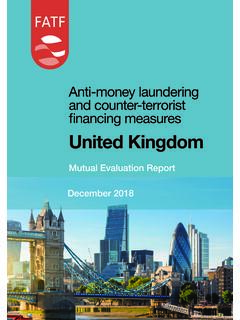Transcription of HIGH-RISK COUNTRIES IN AML MONITORING
1 HIGH-RISK COUNTRIES IN AML MONITORING ALICIA CORTEZ 2 TABLE OF CONTENTS I. Introduction 3 II. HIGH-RISK COUNTRIES 3 Customers 4 Products 7 MONITORING 8 Audit Considerations 8 III. Conclusion 10 IV. References 10 3 I. Introduction This report provides information on the MONITORING process that financial institutions have to develop and implement for detecting and reporting suspicious activity with emphasis on HIGH-RISK COUNTRIES . Policies and procedures focused towards combating money laundering provide the foundation for this fight. They have to address the particular vulnerabilities to which the financial institution is exposed.
2 Policies and procedures have to be enforced to serve their purpose. An audit function, independent of the parties responsible for the MONITORING , should be in place and conducted on a periodic basis. II. HIGH-RISK COUNTRIES Some COUNTRIES and jurisdictions pose a high risk to financial institutions. For example, COUNTRIES subject to Office of Foreign Assets Control (OFAC) sanctions, COUNTRIES identified as supporting international terrorism, jurisdictions determined to be of primary money laundering concern and subject to special measures, offshore financial centers (OFC), and jurisdictions or COUNTRIES with deficiencies in combating money laundering and terrorist financing identified by international entities such as the Financial Action Task Force on Money Laundering (FATF).
3 Information about COUNTRIES can be found in major newspapers, newsletters, account officers, hemispheric agencies and organizations, The World FactBook, Rundt s World Business Intelligence, World-Check, and other publications. Transparency International provides the Corruption Perception Index (CPI). OFAC maintains lists of COUNTRIES , entities and individuals associated with terrorism, money laundering and other sanctioned activities. The OFAC COUNTRIES list is compiled based on national security and United States foreign policy goals. The Financial Action Task Force identifies jurisdictions that have strategic AML/CFT deficiencies and to which counter-measures apply, and jurisdictions with strategic AML/CFT deficiencies that have For HIGH-RISK COUNTRIES Office of Foreign Assets Control (OFAC) Financial Action Task Force (FATF) World-Check The World FactBook Rundt s World Business Intelligence Transparency International 4 not made sufficient progress in addressing the deficiencies or have not committed to an action plan developed with the FATF to address the deficiencies.
4 Each jurisdiction presents different degrees of ML/FT risks. A list of HIGH-RISK COUNTRIES can be found on the FATF website. A financial institution should consider the characteristics of foreign COUNTRIES such as growth, debt, currency, inflation rate, tax rate, banking system, stability and type of government, as well as corruption, terrorist and criminal activity. Some COUNTRIES make it difficult for the people to move their money out of the country, or have strict currency exchange policies. Individuals and businesses will look for alternatives to safeguard their money. Financial institutions must be aware of jurisdictions that have been rated high risk or non-cooperative, and take this information into consideration when selecting their target markets.
5 Maybe the institution is willing to handle a certain level of risk, and include some HIGH-RISK jurisdictions in the target market selection. Recent FATF publications indicated that Argentina, previously identified by FATF as having AML/CFT deficiencies, has been working to correct some deficiencies. However, other deficiencies have not been addressed, which relate to the criminalization of money laundering and suspicious transaction reporting requirements. The FATF also published that Bolivia had improved its AML/CFT controls and corrected the previously identified deficiencies. As such, this country is no longer subject to FATF s AML/CFT compliance MONITORING process.
6 Although FATF identified Mongolia as having improved its AML/CFT controls, the country has not made sufficient progress and some deficiencies remain. Mongolia is encouraged to continue working to address the remaining deficiencies. CUSTOMERS Different types of individuals and businesses in any HIGH-RISK country may seek a relationship with a financial institution in the US. Each type of customer presents different characteristics and poses different levels of risk depending on the nature of business, occupation, or activities. They have different reasons and different needs for establishing a relationship.
7 An example of HIGH-RISK customers follows. 5 Foreign banks and foreign money service providers may want to have access to the US financial system, whose products and services may not be available in their COUNTRIES or are available but are more economically favorable in the US. Non-bank financial institutions are different in size and volume of business and have a diversity of customers, and therefore, these institutions pose different levels of risks to a financial institution. The fact that these businesses may not maintain an ongoing relationship with the customer increases the risk due to the lack of identification requirements.
8 Senior foreign political figures and their immediate family members and close associates (politically exposed persons or PEPs) establish relationships at financial institutions in the US to move their money out of their COUNTRIES . Foreign corporations, offshore corporations, Private Investment Companies (PIC), and international business corporations (IBC) located in higher-risk geographic locations pose a higher risk because it is more difficult to ascertain the validity and adequacy of the documents presented, and to be familiar with the laws and requirements of foreign jurisdictions.
9 Foreign individuals use financial institution products and services for asset preservation, business expansion, and investments. Characteristics of foreign individuals may involve: Need of confidentiality and privacy. The individual may be concerned about the security of the family. This may motivate an individual to open and maintain accounts at US financial institutions. Infrequent physical contact with the financial institution due to the increased use of the fax, email and online financial services. These methods of contact prompt the financial institution to require additional verification of signature on documents sent by fax and call backs to confirm customer instructions.
10 High net worth individuals may be concerned with inflation or the devaluation of currency in their COUNTRIES and want to move funds out of their COUNTRIES . Investment opportunities are also a reason to maintain accounts at the US. In order to predict the types of activity in which the customer is likely to engage in, a customer due diligence process is needed. 6 The process begins with verifying the customer s identity and assessing the risks associated with that customer. The identification process also includes screening customers against OFAC sanction lists, PEP lists, and other lists of adverse information. screening should also be performed in an ongoing basis so new and established customers are compared against new parties added to the lists.
